|
Advantech TREK-674/TREK-306DH
A compact, rugged in-vehicle computing/display system with embedded Stretch S7 H.264 video hardware encoding for fleet management and mobile surveillance applications
(by Conrad H. Blickenstorfer, photography by Carol Cotton)
Advantech designed the TREK-674 as a computer that provides real-time communication between vehicle drivers and their headquarters as well as strong GPS and video capabilities, making it useful for value-added functionality in squad cars, buses, ambulances, garbage trucks, fire engines and other vehicle fleets benefitting from remote monitoring and management. The TREK-674, which Advantech simply calls a "compact in-vehicle computing box for surveillance and fleet management," can operate in the harshest environments, works in an extreme temperature range of -22 to 158 degrees Fahrenheit, and easily survives almost any degree of shock and vibration. It can handle car power, and with its extensive suspend/wakeup functions, the TREK-674 easily fits into 24/7 monitoring systems with its digital input and video recording features.

As the mobile computing component of an automated fleet management and/or high-quality video surveillance system, the TREK-674 adds significant intelligence and data collection capabilities. Its dual storage system allows for very high disk performance as well as video backup onto SSD media, which is quickly retrievable and exchangeable via a locked front compartment. The picture above shows the pieces of a TREK-674-based mobile resource management system, with the TREK-674 unit on the right, and a vehicle monitor (for illustration and test purposes an Advantech TREK-306DH) on the left.
Modern fleet management and in-vehicle surveillance are made possible by a combination of rugged, compact computing equipment that can handle the specific types of punishment of vehicle use; integration with GPS functionality that enables location-based services; and increasing integration of computers into the vehicle itself. Here's how it all works:
- A small, rugged computer system unit can be mounted anywhere in the vehicle, usually in a place where it doesn't get in the way. The system unit is then connected to a compact vehicle display that can be operated both via touch and also with programmable function keys.
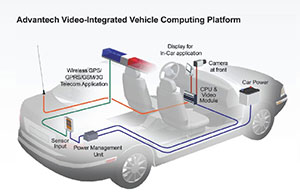 - The system unit may communicate via standard COM ports with such legacy peripherals as printers or barcode readers. It may also communicate with cameras, and with the vehicle directly through a CAN-bus (CAN stands for Controller Area Network and is a vehicle bus standard that lets various systems and devices communicate with one another). That way, the computer can access door locks, temperature controls, alarms, diagnostics, as well as provide visuals of different areas of the vehicle.
- The computer can also access numerous sensors throughout the vehicle, checking variables such as temperatures, pressures, acceleration, direction, etc. Depending on the application, all of this information can be processed and used for fleet management and mobile resource management purposes.
- Now add image capture and processing, GPS and advanced data communication technology, and you have all the components for very sophisticated management systems that can alert to situation as well as move data and information back and forth between vehicles and their dispatch or home base. The opportunities are almost endless.
This is what Advantech had in mind when they introduced the TREK-674 in-vehicle computer as part of the company's extensive fleet management and surveillance systems product lineup.
The Advantech TREK-674 In-Vehicle Computer
If the TREK-674 looks a lot like one of Advantech's industrial PCs, it's because in most respects that is what it is. Many of the environmental requirements that apply to an industrial PC are similar or the same as those that apply to a vehicle computer. It must be as compact as possible for easy placement. It must be rugged enough to withstand abuse. It must be reliable enough to operate 24/7/365 with minimal maintenance and maximum up-time. It must provide suitable performance, generate a minimum of heat and noise, and support the standards and connectivity required for the task.
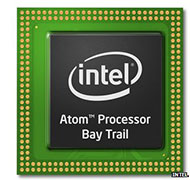 Suitable" performance means as much as is required for the prospective jobs, no more and no less. In this case,the TREK-674 is powered by a dual-core 1.75GHz Intel Atom E3827 processor. Note that this is not one of your father's poky Atom chips. Instead, the E3827 is part of Intel's "Bay Trail" lineup of vastly improved CPUs that are powerful enough to not only be sold under the Atom brand, but also the Celeron and Pentium brands. Suitable" performance means as much as is required for the prospective jobs, no more and no less. In this case,the TREK-674 is powered by a dual-core 1.75GHz Intel Atom E3827 processor. Note that this is not one of your father's poky Atom chips. Instead, the E3827 is part of Intel's "Bay Trail" lineup of vastly improved CPUs that are powerful enough to not only be sold under the Atom brand, but also the Celeron and Pentium brands.
Note that "Bay Trail" is based on the "Silvermont" processor architecture, which is really the first true architectural update to Atom since its introduction in 2008. Bay Trail processors use up to four Silvermont cores, and for the first time in an ultra mobile Intel SoC pairs them with Intel's own graphics IP. In fact, Bay Trail leverages the same GPU architecture as in the Ivy Bridge Core processors, just with fewer EUs (execution units).
The chip supports Windows 7 or Windows 8 both in standard and embedded versions, and Linux. Why not Windows CE as Advantech offers in several other vehicle PCs? Because the size and complexity of many of the applications intended for this platform require full Windows.
Below you can see the TREK-674 from all four sides, as well as from the top.
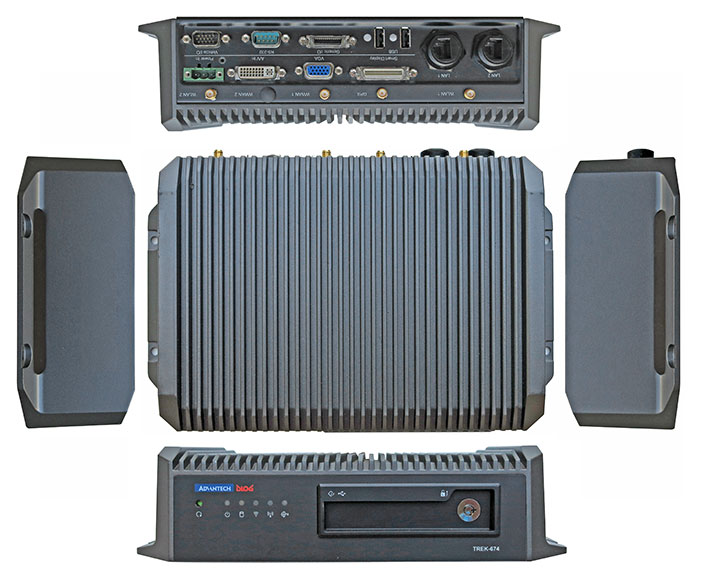
Compared to a conventional desktop PC, the TREK-674, which measures 11.6 x 7.25 x 2.87 inches and weighs just under eight pounds, is a comparatively very compact unit. Its design is dominated by the massive cooling fins of the heat sink that eliminates the need for a fan even under extreme operating temperature conditions. 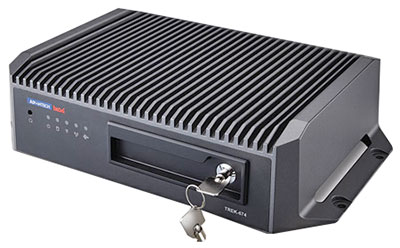 Unlike many industrial PCs where the finned heat sink is simply mounted onto a steel enclosure, in the TREK-674 the heatsink is the housing. It's a massive, super-solid aluminum case with all of the system's electronics fastened directly to it. Unlike many industrial PCs where the finned heat sink is simply mounted onto a steel enclosure, in the TREK-674 the heatsink is the housing. It's a massive, super-solid aluminum case with all of the system's electronics fastened directly to it.
Note the lockable media compartment on the front of the TREK-674. Inside sits the unit's SQFlash solid state disk backup, which by default is a speedy 64GB UMLC SQFlash industrial SSD with a SATA III 6Gbs interface. In addition, there's access to a USB 3.0 port. This arrangement means users can quickly remove and replace storage media.
For access to the interior of the unit, once the device has been unbolted from its mounting position, remove just three small Philips head screws to remove the steel bottom cover. The inside is neat and clean and well designed, as we'd come to expect from Advantech.
For I/O, the TREK-674 offers ample onboard connectivity for just about any task.
On the back side are:
- 2 x USB 2.0 Type A
- 2 x locked-type RJ45 gigabit LAN
- 1 x DB9 RS232 serial port with 12V/1A on pin 9
- 1 x VIO (Vehicle I/O, provides 2 x CAN Bus, 1 x J1708)
- 1 x Generic I/O (4 x isolated DI, 2 x isolated DO, 1 x RS485, 1 x RS232, audio in and out)
- 1 x Smart Display port (provides power, 18-bit LVDS, audio, 2 x UART, USB, power & reset signals)
- 1 x Video/Audio (8-ch video-in, 4-ch audio-in, via DVI-I port)
- 1 x GPS antenna port
- 2 x WLAN antenna port
- 2 x WWAN antenna port
On the front, the TREK-674 has no ports, but:
- LED indicator for power status
- LED indicator for storage status
- LED indicator for GPS status/activity
- LED indicator for WWAN status/activity
- LED indicator for WLAN status/activity
Note that the TREK-674 is meant to work with one of Advantech's In-Vehicle Smart Display's specifically designed for the task. Connection is via a Smart Display cable that carries not just video, but also power, audio, UART, USB, as well as reset signals.
Also unique to the system is its embedded Stretch S7 H.264 video hardware encoder that supports up to eight analog video inputs with up to D1 (740 x 480) resolution at 30 frames per second. The documentation isn't specific as to which exact Stretch S7 circuitry is included, but the gist of it is that this allows the TREK-674 to process real-time video, full-speed input from up to eight onboard cameras in reasonably high resolution (see Stretch S7 product sheet).
What about performance of the Intel Atom E3827 SoC-based unit? Here, as always, Advantech picked the processor best matched to the intended purpose and load of the system. Unlike general purpose PCs where more performance is always better, in dedicated systems excess power simply means extra cost and heat, both to be avoided. The table below shows, simply to give an idea of the overall performance of the TREK-674, where the system stands compared to some other Advantech industrial PCs that we've had in the RuggedPCReview.com lab recently.
|
Advantech Intel-based Box PC Benchmarks and Comparisons
|
|
PERFORMANCE COMPARISON
|
Advantech
|
Advantech
|
Advantech
|
Advantech
|
Advantech
|
|
Model
|
TREK-674
|
AIIS-1240
|
ITA-1610
|
ARK-1122
|
ARK-DS520
|
|
Model (click pic for review)
|

|

|

|

|

|
|
Year tested
|
2014
|
2014
|
2014
|
2013
|
2012
|
|
What's it for?
|
Vehicle/surveillance
|
Optical inspection
|
Intelligent systems
|
Digital signage
|
Digital signage
|
|
Intel processor
|
Atom E3827
|
Core i7-3770
|
Atom D525
|
Atom N2800
|
Atom N455
|
|
CPU Speed
|
1.75GHz
|
3.4GHz
|
1.8GHz
|
1.86GHz
|
1.66GHz
|
|
OS Software
|
WES7
|
WES7
|
WES7
|
WES7
|
WES7
|
|
Thermal Design Power (TDP)
|
8 watts
|
77 watts
|
13 watts
|
6.5 watts
|
6.5 watts
|
|
CPU Mark
|
628.7
|
8,820.9
|
556.8
|
546.1
|
248.7
|
|
2D Graphics Mark
|
124.9
|
696.5
|
182.7
|
NA
|
71.3
|
|
Memory Mark
|
314.2
|
1,420.5
|
266.2
|
254.3
|
220.4
|
|
Disk Mark
|
1,486.9
|
519.5
|
101.8
|
948.2
|
445.9
|
|
3D Graphics Mark
|
125.5
|
476.4
|
106.8
|
57.0
|
169.1
|
|
Overall PassMark
|
556.2
|
2,895.9
|
257.0
|
389.7
|
226.3
|
|
CM ALU
|
12,009
|
84,049
|
12,214
|
11,474
|
6,296
|
|
CM FPU
|
9,876
|
68,910
|
10,276
|
9,003
|
4,033
|
|
CM MEM
|
14,748
|
47,498
|
8,649
|
8,757
|
6,033
|
|
CM HDD
|
36,844
|
8,325
|
5,381
|
25,739
|
7,827
|
|
CM GDI
|
3,465
|
17,856
|
2,798
|
1,271
|
2,302
|
|
CM D2D
|
3,490
|
8,411
|
3,481
|
370
|
2,936
|
|
CM OGL
|
2,667
|
10,417
|
787
|
8,016
|
5,183
|
|
Overall CrystalMark
|
83,099
|
245,466
|
43,586
|
64,630
|
34,610
|
The Advantech TREK-306DH Smart Display
Advantech has been using a special, optimized design for in-vehicle displays and computers for a while now. Why? Because it would't make sense to simply have any remote LCD work with a dedicated systems such as the TREK-674. A vehicle display must meet the following requirements:
- It must be able to handle an automotive grade temperature range (-22 to 158 degrees F)
- It must be able to handle shock and vibration
- It must be well sealed
- It must have an ambient light sensor
- It should have both touch and physical programmable function buttons
- It should have a one-cable connection
- It should provide USB, reset and power on/off
The TREK-306DH does all that. It is a 5-wire resistive touch panel that measures about 12 x 9 inches and is about an inch and a half thick. Its 10.4-inch display is large enough to be useful for all sorts of fleet management, GIS and video surveillance applications. 1024 x 768 XGA resolution, likewise, is adequate for the application, and it's still an industry standard for which numerous vertical party applications have been optimized. The TREK-306DH's five user-programmable function keys are large and make for easy operation even on bumpy rides. Its plastic housing is tough, carries IP55 sealing, and is compatible with RAM mounting solutions so that customers can easily install it according to their requirements.
Perhaps most importantly, the display connects to the TREK-674 (or similar TREK systems) with a single powered Smart Display cable, which Advantech offers in lengths of two (6.5 feet) or five meters 16.5 feet).
Below you can see the Advantech TREK-306DH Smart Display from the front and all sides.
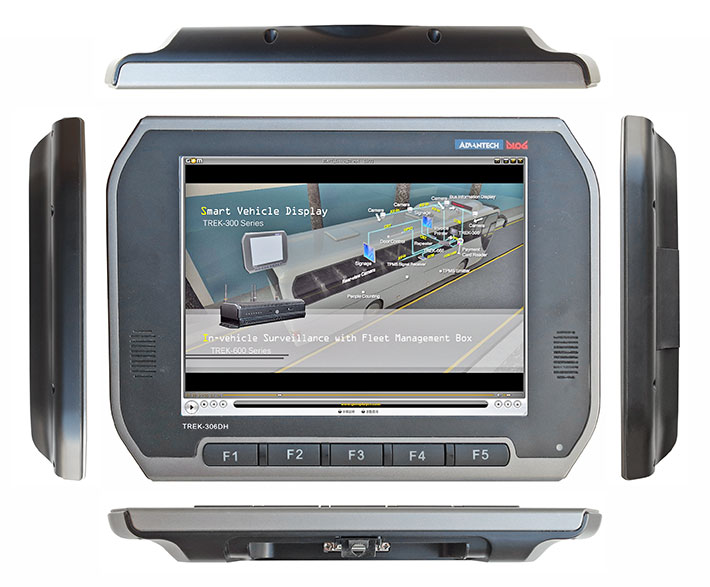
Additional thoughts about TREK-based Mobile Resource Management systems
As an early adopter of GPS technology (mid 1990s) and also having some experience with OBD-II, which stands for "OnBoard Diagnostics," the increasing use of computers in vehicles is no surprise to me, nor is the increasing sophistication and innovation of such uses. In fact, we're probably seeing just the beginning, especially given the emergence of increasingly useful IoT applications.
It is hard to overestimate the potential benefit of mobile resource management and video surveillance. Intelligent fleet monitoring can revolutionize the way a business is run. In addition to basics like theft protection, dispatchers and fleet management know at any time where their vehicles are, what routes they have run, what the odometer reading is, if safety requirements are met, and whether they are being used according to plan and policy.
An advanced system may not only provide vehicle location on a map, geofences, remote alarms and door unlocking, but also detailed history reports that can show hourly usage, violations, speeding, or many other parameters. The addition of multiple video streams alerts to dangers, unusual situation, and provides documentation.
All sorts of special sensors can be used to retrieve information from the OBD-II onboard diagnostics system that has been mandatory in vehicles sold in the United States since 1996. OBD-II tracks dozens of vehicle functions, and that data could be used to provide fuel efficiency data, warn of potential vehicle and component failures or manage maintenance requirements. And the industry is just beginning to meld the up to now completely separate world of vehicle computers, generally known as ECUs (Engine Control Units), with computers and communication systems as we know them.
If all this sounds enormously complicated, it is and it's not. Installation of a GPS vehicle tracking system is inherently no more difficult than that of a car audio or navigation system. Setting up web-based tracking reports is simple as well, and can be done both for individual vehicles as well as for small and large fleets.
How much does it cost? That depends on the type and system as well as the software it comes with. Developers and systems integrators may use the rugged Advantech TREK platform to create simple or complex vehicle and fleet management systems. IT departments may build their own applications using Advantech tools and standard Windows development environments. TREK based systems may be deployed as inhouse applications, or sold as turnkey or subscription-based systems.
Mobile Resource Management, video surveillance, and GPS-based M2M systems are becoming increasingly popular as they easily pay for themselves with numerous benefits, including theft protection, asset management, increased safety, lowered maintenance costs, more efficient operation, route management, etc. 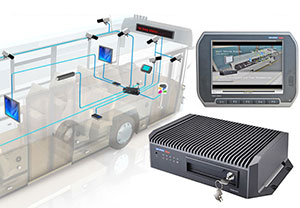 Increasingly we're seeing systems optimized for specific tasks, like the TREK-674's emphasis on video surveillance and recording from up to eight channel cameras, which can safely and easily provide video data monitoring and backup for numerous field operations. Increasingly we're seeing systems optimized for specific tasks, like the TREK-674's emphasis on video surveillance and recording from up to eight channel cameras, which can safely and easily provide video data monitoring and backup for numerous field operations.
In summary...
With the TREK-674, Advantech offers an innovative compact in-vehicle computer for surveillance and fleet management applications. The system is simple to install and use, can interact with vehicles and sensors, and offers superior wireless connectivity with dedicated external antennae to streamline operations, optimize vehicle use, and reduce errors, fuel usage and overall costs, all on top of providing powerful video surveillance capabilities.
-- Conrad H. Blickenstorfer, October 2014
Advantech TREK-674 Specs:
| Type |
Compact ruggedized in-vehicle computer
|
| Added |
Added 10/2014
|
| Processor |
Dual-core 1.75GHz Intel Atom E3827
|
| OS |
Windows Embedded Standard 7, Windows 7, Windows Embedded Standard 8, Windows 8, Linux
|
| GNSS |
u-blox LEA-6S module with A-GPS support, optional: Galileo/BeiDou module |
| RAM |
2GB or 4GB DDR3L 1066/1333 in one SO-DIMM socket |
| Storage |
1 x externally accessible CFAST (default 16GB SLC SQFlash that supports system boot), 1 x externally accessible, lockable 2.5-inch SSD tray (default 64GB UMLC SQFlash SATA III 6Gbs industrial SSD) |
| Display |
Use TREK-303 or TREK-306
|
| Expansion/slots |
1 x mini-PCIe, 2 x mini-SIM |
| Display interface |
1 x Smart Display Port (combines 18-bit LVDS out (800 x 480 or 1024 x 768), 2 x UART, audio out, 2 x USB 2.0 Type A, 12V power, power and reset signals), 1 x VGA |
| Housing |
Steel/aluminum |
| Size |
11.6 x 7.25 x 2.87 inches (294 x 184 x 73 mm) |
| Weight |
7.7 pounds (3.5 kg)
|
| Operating temperature |
-22° to 158° degrees Fahrenheit (-30° ~ 70° degrees Celsius) |
| Humidity |
unknown |
| Vibration and shock |
MIL-STD-810G, Method 516.5, EN60721-3(5M3) |
| EMC |
CE, FCC, CCC |
| Sealing |
IP30 |
| Power |
Supports 12/24V car power systems (9V ~ 32V DC input, ISO 7637-2, SAE J1113)
|
| Interface |
Vehicle I/O port (2 x CAN Bus, 1 x J1708 with J1587 support)
Standard I/O: 1 x USB 3.0, 1 x USB 2.0, 1 x RS232, 2 x locked-type RJ45 LAN
Generic I/O: 1 x RS485, 1 x 4-wire RS232, 4 x isolated DI, 4 x isolated DO, 1 x line-out, 1 x mic-in
Video: 8-channel video-in, 4-channel mono audio-in
|
| Wireless |
Dual-band 802.11a/b/g/n + Bluetooth 4.0, WWAN (HSPA+, GSM/GPRS/EDGE: Sierra Wireless AirPrime MC809x via mini PCIe slot; optional CDMA 1xRTT/EV-DO Rev.A: Sierra Wireless AirPrime MC9090 via mini PCIe slot), optional 4G (LTE,HSPA+,GSM/GPRS/EDGE, EV-DO Rev a1, 1xRTT): Sierra Wireless MC73xx via mini PCIe slot), 5 x SMA type antenna hole for GPS/ WWAN/ WLAN/ BT/ LTE |
| Certifications |
CE (R&TTE), FCC ID |
| Price |
inquire |
| Product brochure |
TREK-674 brochure (PDF)
|
| Product web page |
Advantech Advantech TREK-674 web page |
Advantech TREK-306DH Specs:
| Type |
10.4-inch Smart Vehicle Display
|
| Added |
10/2014
|
| LCD size |
10.4-inch diagonal
|
| LCD resolution |
1024 x 768 pixel XGA |
| LCD brightness |
400 nits (typical) with touchscreen, LED backlight |
| LCD viewing angles |
178/178 degrees |
| LCD contrast ratio |
1,400 : 1
|
| Touchscreen |
5-wire resistive
|
| Hardware controls |
Five user-defined function keys, power/wake-up, brightness control |
| Power |
12 Volt (supplied via TREK-576 system unit)
|
| Housing |
Plastic |
| Size |
11.9 x 8.9 x 1.4 inches (303 x 226 x 35 mm) |
| Weight |
3.75 lbs. (1.7 kg)
|
| Operating temperature |
-22 to 158 degrees Fahrenheit (-30 ~ 70 degrees Celsius) |
| Humidity |
unknown |
| Vibration |
MIL-STD-810G, EN60721-3(5M3), SAE J1455 4.9.4.2 |
| Sealing |
IP 55
|
| Interface |
1 x USB 2.0 host, 1 x Smart Display Port |
| Product brochure |
TREK-306DH brochure (PDF)
|
| Price |
inquire |
| Web page |
Advantech TREK-306DH web page |
Advantech Corporation
13 Whatney
Irvine, CA 92618
Toll Free: 1-800-866-6008
Ph: 949-420-2500
Fax: 949-420-2501
ECGInfo@advantech.com
www.advantech.com
Advantech Co. Ltd.
No.1, Alley 20, Lane 26, Rueiguang Road
Neihu District, Taipei Taiwan 114, R.O.C.
Tel: 886-2-2792-7818
Fax: 886-2-2794-7301
www.advantech.com
|







 Suitable" performance means as much as is required for the prospective jobs, no more and no less. In this case,the TREK-674 is powered by a dual-core 1.75GHz Intel Atom E3827 processor. Note that this is not one of your father's poky Atom chips. Instead, the E3827 is part of Intel's "Bay Trail" lineup of vastly improved CPUs that are powerful enough to not only be sold under the Atom brand, but also the Celeron and Pentium brands.
Suitable" performance means as much as is required for the prospective jobs, no more and no less. In this case,the TREK-674 is powered by a dual-core 1.75GHz Intel Atom E3827 processor. Note that this is not one of your father's poky Atom chips. Instead, the E3827 is part of Intel's "Bay Trail" lineup of vastly improved CPUs that are powerful enough to not only be sold under the Atom brand, but also the Celeron and Pentium brands.

 Unlike many industrial PCs where the finned heat sink is simply mounted onto a steel enclosure, in the TREK-674 the heatsink is the housing. It's a massive, super-solid aluminum case with all of the system's electronics fastened directly to it.
Unlike many industrial PCs where the finned heat sink is simply mounted onto a steel enclosure, in the TREK-674 the heatsink is the housing. It's a massive, super-solid aluminum case with all of the system's electronics fastened directly to it.






 Increasingly we're seeing systems optimized for specific tasks, like the TREK-674's emphasis on video surveillance and recording from up to eight channel cameras, which can safely and easily provide video data monitoring and backup for numerous field operations.
Increasingly we're seeing systems optimized for specific tasks, like the TREK-674's emphasis on video surveillance and recording from up to eight channel cameras, which can safely and easily provide video data monitoring and backup for numerous field operations.